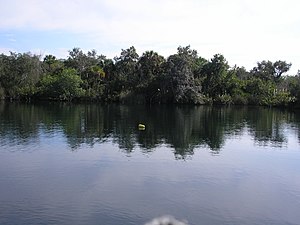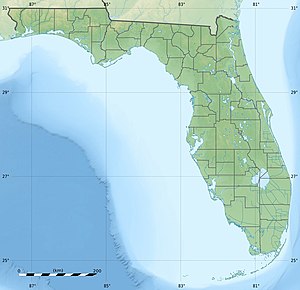Little Salt Spring
| Little Salt Spring | ||
|---|---|---|

|
||
| Little Salt Spring photographed from the middle of the lake | ||
| Geographical location | West Florida | |
| Tributaries | Groundwater | |
| Drain | Groundwater | |
| Islands | no | |
| Places on the shore | North Port | |
| Data | ||
| Coordinates | 27 ° 4 '29 " N , 82 ° 14' 0" W | |
|
|
||
| surface | 0.436 ha | |
| length | 79 m | |
| width | 70 m | |
| scope | 234 m | |
| Maximum depth | 76 m | |
|
particularities |
||

|
||
| NASA satellite image of Little Salt Spring with surroundings | ||
The Little Salt Spring is an archaeological and paleontological site in Sarasota County in the west of the US state Florida . The site in North Port Butler Park was added to the National Register of Historic Places on July 10, 1979 .
geology
Originally it was assumed that the Little Salt Spring is a relatively shallow freshwater pond. It was not until the 1950s that divers discovered that there is a very deep, real karst funnel. These sinkholes represent a typical feature of the karst landscape of Florida. The lake has a diameter of about 70 meters on the water surface. The profile of the karst funnel is roughly hourglass-shaped. First of all, the bottom of the lake drops evenly from the banks to a depth of around 12 meters, where it forms the narrowest point with an average diameter of 14 meters. Below that, the cave widens again, forming a small step at a depth of 16 meters and a larger, sharply defined step at a depth of 27 meters. Below that, the cave widens continuously to the bottom. The greatest depth determined to date is around 76 meters at the outer edges of the cave and around 60 meters below the current water level in the middle under the lake. The bottom of the cave is 73 meters in diameter. The sinkhole is fed with oxygen-poor groundwater through numerous openings in the bottom , which creates hypoxic conditions below a water depth of 3 meters and extremely affects aquatic life. This lack of oxygen favors the preservation of Paleo-Indian and early Archaic artifacts such as fossil bones from the extinct megafauna that once colonized Florida.
The lake has belonged to the University of Miami since 1980 and was designed by Dr. John Gifford of the Rosenstiel School of Marine and Atmospheric Science at the University of Miami.
Findings
Over time, the lake's water level varied greatly. 12,000 to 13,000 years ago, the sea level was about 100 meters lower than it is today, which also lowered the water table on the Florida peninsula. The lake level was 27 meters below today's surface. Later dead plant material accumulated in the basin of the lake and the surrounding swamp. Numerous burials from around 4800 to 3200 BC have been excavated in the swamp and, similar to Windover , well-preserved remains of tissue have been recovered from the remains. In the 1970s, a shell of a now extinct giant tortoise was recovered on the step at a depth of 27 meters , through which a wooden stick had been driven. Scorch marks on the object indicate that it may have been cooked over a fire. The 14 C-dating of a sample from the wood gave an age of 12,030 years and the sample from a bone of the turtle gave an age of 13,450 years. In addition, a large number of human bones were discovered that had been preserved by the deoxygenated water, but were not recovered.
literature
- Barbara A. Purdy: Florida's People During the Last Ice Age . University Press of Florida, Gainesville 2008, ISBN 978-0-8130-3204-7 (English).
Individual evidence
- ↑ Entry in the National Register Information System . National Park Service , accessed May 12, 2016
- ↑ Little Salt Spring Reveals More Florida History . July 6, 2005.
- ^ CJ Clausen, AD Cohen et al .: Little Salt Spring, Florida: A Unique Underwater Site . In: Science . 203, No. 4381, February 16, 1979, pp. 609-614. doi : 10.1126 / science.203.4381.609 .
- ↑ Carlos A. Alvarez Zarikiana, Peter K. Swart et al .: Holocene paleohydrology of Little Salt Spring, Florida, based on ostracod assemblages and stable isotopes . In: Palaeogeography, Palaeoclimatology, Palaeoecology . 225, No. 1-4, August 5, 2005, pp. 134-156. doi : 10.1016 / j.palaeo.2004.01.023 .
- ↑ Purdy: 84-90
Web links
- Little Salt Spring - Detailed page on the site of the School of Marine and Atmospheric Science
- Entry Sarasota County in the National Register of Historic Places (English)
- Entry Sarasota County in Florida's Office of Cultural and Historical Programs (English)
